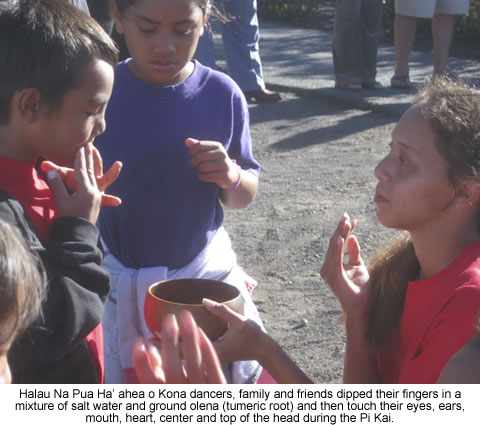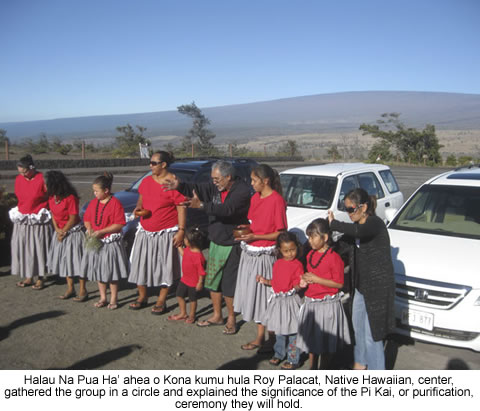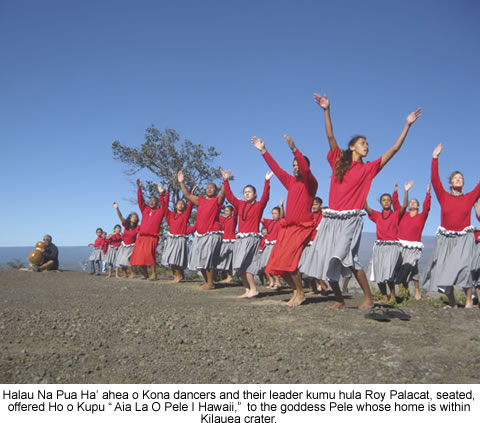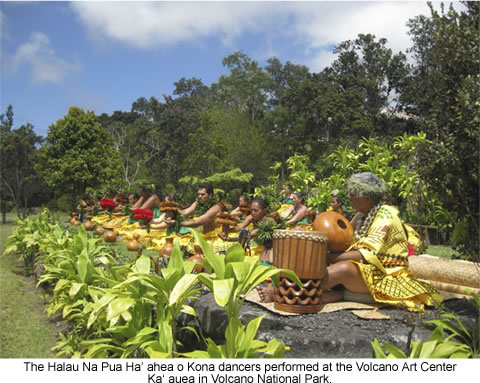 |
Canku Ota
|
 |
|
(Many Paths)
|
||
|
An Online Newsletter
Celebrating Native America
|
||
|
December 1, 2010 - Volume
8 Number 12
|
||
|
|
||
|
Kona Hula Halau Pays
Tribute To The Goddesses Pele And Hi'iakaikapoliopele
|
||
|
by Rebecca Jacobs -
Indian Country Today correspondent
|
||
|
credits: All photos by
Rebecca Jacobs for Indian Country Today
|
|
“We have to go see her first,” Halau Na Pua Ha’aheo o Kona kumu hula Roy “Bobo” Palacat, Native Hawaiian, said. “If we had danced and then gone to the crater, no, that would not have been right.” The first ceremony, the Pi Kai, brought the group into a large circle where they joined hands, prayed and chanted. Palacat stressed the importance of the cleansing they were about to undertake. Then, two dancers came forward with bowls of salt water mixed with ground olena, tumeric root, to ward off evil. Palacat dipped his fingers in the water and touched his eyes so that everything he would see would be pure. He then dipped his fingers and touched his mouth so that every word from his mouth would be pure. Alternating between the water and then his ears, his heart, his center, and then the top of his head connecting himself to his ancestors, Palacat blessed and purified his being.
Palacat explained that Hawaiian language is wrought with layers and levels of meaning, which can muddle an individual’s actions. During the Pi Kai, the participants are readied to stay focused in everything they do and be guided by their spiritual power. “This is so that our whole body is encased in pono [honor and righteousness]” he said. After Palacat’s blessing, each of the dancers and their supporters also followed in the blessing-way. Had the group been at the ocean’s edge, they would have immersed themselves rather than using the bowl of salt water and olena. The group then made the pilgrimage to the very edge of the crater for the Ho o kupu, ceremony to pay tribute to Pele. There, they offered a lei and two dances as Palacat, their leader and choreographer, chanted and played the gourd instrument called the ipu.
Alohi Abraham, Native Hawaiian, who has been dancing for 25 years, said the offering was critical to show their honor for Pele. “It’s important to be there, letting Pele know that we are there for her dancing for her and praying for her,” she said. Following the offerings, the group returned to the Volcano Art Center for their performance on the hula platform. This setting was constructed in 1980 and faces Kilauea with Mauna Loa to the north. The group’s performance, He Lei Aloha No Hi’iakaikapoliopele, consisted of approximately 12 dances and was a tribute to Pele’s youngest and most loved sister, Hi’iakaikapoliopele. Through the performance, Palacat orated the story of the sisters’ move from their ancestral homelands to the Big Island of Hawaii and their origination of the hula.
The performance detailed the nature of Pele as one who shows her anger and frustration with her lava flows and Hi’iaka’s character as a healer and rejuvenator. “When Pele comes over the land, Hi’iaka comes after her,” Palacat said. “She brings the rain, the trees, the plants to heal the land. You could not have one without the other.” The performance, Palacat explained, was a metaphorical lei. Each dance represented a flower in a lei and the entire show was a lei — a gift being given in honor of Hi’iakaikapoliopele and Pele.
For more information about the Volcano Art Center and the Hula Kahiko Performance Series, visit www.volcanoartcenter.org. |
|
|
||
|
|
||
| Canku Ota is a free Newsletter celebrating Native America, its traditions and accomplishments . We do not provide subscriber or visitor names to anyone. Some articles presented in Canku Ota may contain copyright material. We have received appropriate permissions for republishing any articles. Material appearing here is distributed without profit or monetary gain to those who have expressed an interest. This is in accordance with Title 17 U.S.C. Section 107. | ||
|
Canku Ota is a copyright ©
2000, 2001, 2002, 2003, 2004, 2005, 2006, 2007, 2008, 2009, 2010
of Vicki Barry and Paul Barry.
|
||
 |
 |
|
|
The "Canku
Ota - A Newsletter Celebrating Native America" web site and
its design is the
|
||
|
Copyright ©
1999, 2000, 2001, 2002, 2003, 2004, 2005,
2006, 2007, 2008, 2009, 2010
of Paul C. Barry.
|
||
|
All Rights Reserved.
|
||
 VOLCANO,
Hawaii – As the sun rose over the ocean and made its way to
Kilauea crater, Halau Na Pua Ha’aheo o Kona dancers, their
friends and family gathered to purify themselves and pay homage
to the goddess of the Hawaiian volcano, Pele. The hula dancing group’s
morning began hours earlier when they left their homes in Kona to
reach the goddess’ home, Halema’uma’u, by sunrise.
Later that morning, they would take the stage for a Hula Kahiko
performance at the Volcano Art Center. But first, they needed to
follow protocol and recognize whose home it was they were in.
VOLCANO,
Hawaii – As the sun rose over the ocean and made its way to
Kilauea crater, Halau Na Pua Ha’aheo o Kona dancers, their
friends and family gathered to purify themselves and pay homage
to the goddess of the Hawaiian volcano, Pele. The hula dancing group’s
morning began hours earlier when they left their homes in Kona to
reach the goddess’ home, Halema’uma’u, by sunrise.
Later that morning, they would take the stage for a Hula Kahiko
performance at the Volcano Art Center. But first, they needed to
follow protocol and recognize whose home it was they were in.
 “This
first prayer ceremony is to our ancestors. They stand to the back
of us, they stand to the front, to the sides, they are all around
us. We ask them to give us knowledge, insight, wisdom and strength.”
“This
first prayer ceremony is to our ancestors. They stand to the back
of us, they stand to the front, to the sides, they are all around
us. We ask them to give us knowledge, insight, wisdom and strength.” “We
do this to say, ‘Yes, Pele is here. She lives here, she dances
here. Yes, she is living here on our island, but not just here all
the way to Maui. This is her home.’”
“We
do this to say, ‘Yes, Pele is here. She lives here, she dances
here. Yes, she is living here on our island, but not just here all
the way to Maui. This is her home.’” In
the legend, it is Pele who spawns the growth of hula when she sees
two women dancing on a beach in the Puna district of the Big Island
and requests that one of her sisters dance. When none of them step
forward except the tiny, Hi’iaka, Pele is skeptical. Hi’iaka,
however, amazes everyone with her dance. Into the future, it is
Hi’iakaikapoliopele and Pele who perpetuate the dance.
In
the legend, it is Pele who spawns the growth of hula when she sees
two women dancing on a beach in the Puna district of the Big Island
and requests that one of her sisters dance. When none of them step
forward except the tiny, Hi’iaka, Pele is skeptical. Hi’iaka,
however, amazes everyone with her dance. Into the future, it is
Hi’iakaikapoliopele and Pele who perpetuate the dance. As
the performance came to a close, Volcano Art Center Education Coordinator
Marsha Hee explained the depth of the Hawaiian hula as more than
entertainment. Rather, it represents the vibrant culture and living
history of the Hawaiian people. Palacat has been studying hula and
Hawaiian history for a lifetime. At his halau, hula school, he offers
three levels of hula classes to individuals of all cultures. In
response to Hee’s words, the audience loudly applauded and
rose to their feet.
As
the performance came to a close, Volcano Art Center Education Coordinator
Marsha Hee explained the depth of the Hawaiian hula as more than
entertainment. Rather, it represents the vibrant culture and living
history of the Hawaiian people. Palacat has been studying hula and
Hawaiian history for a lifetime. At his halau, hula school, he offers
three levels of hula classes to individuals of all cultures. In
response to Hee’s words, the audience loudly applauded and
rose to their feet.